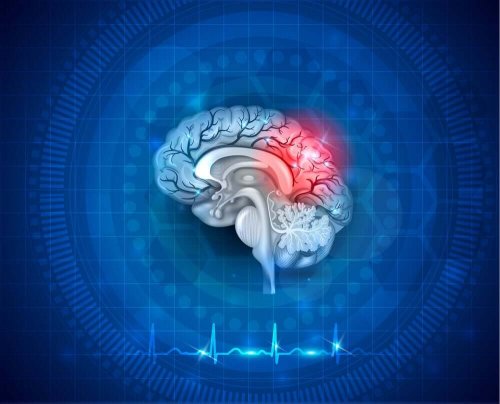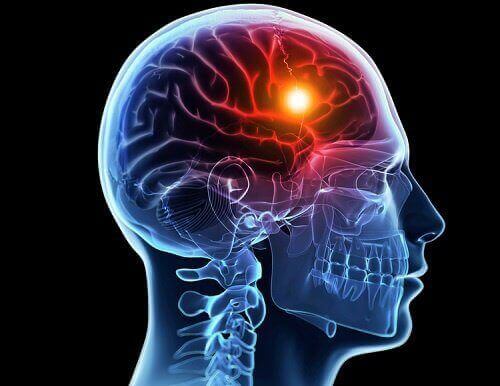Cerebral Hypoxia: Types and Causes


Written and verified by the doctor Leonardo Biolatto
Cerebral hypoxia occurs when there’s less flow of oxygen to the brain than what’s considered normal. A normal flow of oxygen allows the brain to function properly, as per the body’s requirements.
You must understand that the brain is an organ whose functions mustn’t stop. Different parts of the brain activate at different times but the rest of the components of the human body depend on their correct performance.
Due to its constant functioning, the brain consumes a large amount of oxygen. In addition, oxygen comes through the arteries that distribute the blood from the neck up. Thus, if the blood decreases, so will the oxygen.
A lack of oxygen greatly affects the brain. The cells that compose it begin their death process when they go about five minutes without oxygen. This is known as cerebral infarction, and demonstrates the relevance that an episode of cerebral hypoxia may have.
Causes of cerebral hypoxia
The causes behind cerebral hypoxia vary. Sometimes, it’s merely due to a decrease in the oxygen that reaches the skull region. And other times, there’s also a decrease in blood flow in addition to oxygen, with all that this implies.
Some of the causes:
- Altitudes above sea level lead to a decrease in the oxygen available to the brain to function. This is the altitude sickness associated with the practice of sports such as climbing and mountaineering.
- Carbon monoxide is the main representative of gas poisoning. When it occurs, oxygen loses its place in the blood and carbon monoxide replaces it. This way, cells throughout the body receive an element that they can’t use for their metabolism.
- Some pathologies, such as amyotrophic lateral sclerosis, for example, attack the brain’s breathing center, paralyzing the respiratory muscles. When the respiratory mechanism fails, less oxygen goes in and it causes a choking-like mechanism.
- Choking, either intentionally, with criminal motives, or accidentally, both cause cerebral hypoxia. Tightening the neck, drowning with liquids, and inhaling fumes from a fire are some of the different forms of suffocation.
- Arterial hypotension happens when blood pressure drops too low and becomes insufficient to irrigate all the body tissues, especially those farthest from the heart. The brain is one of the areas affected by this.
- Any heart disease that limits your normal pumping capacity and pace can lead to cerebral hypoxia. It may be an acute event, such as a myocardial infarction, or a chronic situation such as arrhythmias.
- Strokes produce cerebral hypoxia in certain regions, either due to clogging of a cerebral artery with a clot, or because of a section of the vessels in the brain breaks and causes bleeding.

Read on: Brain Metastases – Description and Treatment
Types of presentation
One can classify cerebral hypoxia depending on the affected brain area. Some hypoxic episodes only hurt cells of a particular point in the brain, while there are times when the general flow stops.
Thus, these are the types of cerebral hypoxia:
- Focal. In this case, cerebral hypoxia is punctual. The classic example is a stroke that originates in a clot that clogs a cerebral artery.
- Diffuse. This is a decrease in cerebral oxygen flow that happens evenly throughout the brain, without becoming too serious. The functions of brain cells decrease, but infarction rarely happens.
- Global. In this one, the reduction affects the whole brain. The lack of oxygen is so noticeable that cells die. The subsequent symptoms are according to the affected brain area.
- Massive. This is the maximum expression of cerebral hypoxia, where large areas of the brain infarct at the same time, putting subsequent recovery and life at risk.

Symptoms of cerebral hypoxia
Even though the symptoms of cerebral hypoxia depend on how long the lack of oxygen lasts for, some of its signs are quite distinctive. As we mentioned above, hypoxia of a few seconds may not leave sequels, but, if it extends for five minutes, there’ll surely be a stroke.
There may be a lack of attention, some memory loss, funny sensations in the extremities of the body, and speech difficulty after momentary cerebral hypoxia. There may also be limited movement, similar to paralysis.
If the lack of oxygen flow lasts longer then there’ll be subsequent seizures, fainting with loss of consciousness and the person can even go into a coma. At this point, urgent care becomes a must as the person will require immediate life support measures from a medical team.
If the cerebral hypoxia exceeds five minutes, then there’ll be a heart attack. A small heart attack can lead to a subsequent recovery with rehabilitation, but a massive heart attack could cause the death of the entire brain.
So, you must consult with a doctor if you experience any neurological symptoms. Similarly, if a person faints and doesn’t react immediately or has convulsions, then the right step is to contact an emergency care service that can help them quickly.
All cited sources were thoroughly reviewed by our team to ensure their quality, reliability, currency, and validity. The bibliography of this article was considered reliable and of academic or scientific accuracy.
- Flores-Compadre, José Luis, et al. “Hipoxia perinatal y su impacto en el neurodesarrollo.” Revista chilena de neuropsicología 8.1 (2013): 26-31.
- Rodríguez-Boto, G., et al. “Conceptos básicos sobre la fisiopatología cerebral y la monitorización de la presión intracraneal.” Neurología 30.1 (2015): 16-22.
- Sánchez Silva, Daniel José. “Protección Cerebral ante el Daño Neuronal.” Informe Médico 13.10 (2011).
This text is provided for informational purposes only and does not replace consultation with a professional. If in doubt, consult your specialist.








